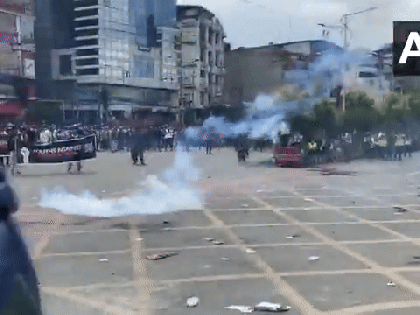Nepal: One killed, dozens injured in 'Gen Z' protest as police use teargas, rubber bullets to disperse demonstrators
By ANI | Updated: September 8, 2025 14:40 IST2025-09-08T14:35:12+5:302025-09-08T14:40:08+5:30
Kathmandu [Nepal], September 8 : A Gen Z protester has reportedly died and several others have been injured as ...

Nepal: One killed, dozens injured in 'Gen Z' protest as police use teargas, rubber bullets to disperse demonstrators
Kathmandu [Nepal], September 8 : A Gen Z protester has reportedly died and several others have been injured as nationwide demonstrations against government corruption and the recent social media ban intensified, particularly in Kathmandu's New Baneshwor and Damak in Jhapa district on Monday, as reported by The Himalayan Times.
According to The Himalayan Times, the protester, believed to have been shot during violent clashes in New Baneshwor, succumbed to injuries while undergoing treatment at Civil Hospital. The identities of several injured individuals remain unknown at this time.
In Damak, protesters marched from Damak Chowk towards the municipal office, where they burnt an effigy of Nepalese Prime Minister KP Sharma Oli and attempted to breach the office gates. Police responded with water cannons, teargas, and rubber bullets, critically injuring one demonstrator, The Himalayan Times reported. Several motorcycles were also set ablaze, escalating tensions in the area.
Demonstrators were also seen throwing teargas back at the police, who had retreated to a corner of the street, making a huddle, and using riot shields to protect from incoming projectiles.
Multiple journalists and photographers were also injured while covering the protests in New Baneshwor.
Among them were Dipendra Dhungana from Naya Patrika, Umesh Karki from Nepal Press, and Shyam Shrestha from Kantipur Television, all of whom were hit by rubber bullets and are receiving treatment at Civil Hospital, The Himalayan Times reported.
The Nepali Army has also been deployed to New Baneshwor as tensions escalated shortly after a curfew was enforced in the area.
The protest, which began as a peaceful march, escalated when protesters broke through barricades and entered restricted zones near Parliament, with police resorting to hard measures after demonstrators threw tree branches and water bottles and shouted anti-government slogans, with some protesters reportedly managing to enter the Parliament compound, intensifying the situation.
In response to the unrest, the Kathmandu District Administration Office extended the curfew initially imposed in the capital's Baneshwar area. The new curfew now includes several high-security zones, such as the President's residence (Shital Niwas), the vice-president's residence in Lainchaur, Maharajgunj, all sides of Singha Durbar, the prime minister's residence in Baluwatar, and adjacent areas, as reported by The Kathmandu Post.
Chief District Officer Chhabilal Rijal issued the curfew order under Section 6 of the Local Administration Act and will remain in effect from 12:30 PM to 10:00 PM (local time).
The public has been strictly prohibited from movement, gatherings, protests, or encirclement activities within these zones.
According to The Kathmandu Post, protests come in the wake of the Nepal government's decision to ban 26 unregistered social media platforms, including widely used apps such as Facebook, Instagram, WhatsApp, YouTube, and Snapchat. The move has sparked public outrage, especially among young people, who accuse the government of stifling free expression while failing to address deep-seated corruption.
As the protests gained momentum, leading Nepali artists, actors, and entertainers voiced their support, further amplifying the movement.
Nepalese actor Hari Bansha Acharya posted on Facebook, saying, "Today's youth do more than just thinkthey ask questions. Why did this road collapse? Who is accountable? This is not a voice against the system but against those who misuse it."
He urged political leaders to take responsibility and prepare the next generation for leadership.
Singer and actor Prakash Saput publicly supported the protestors by sending NRs 25,000 each to two brothers participating in the protests, advising them to stay hydrated and use the funds to help fellow demonstrators, The Kathmandu Post reported.
Rage against the Nepalese government erupted after it decided to shut down over two dozen social media platforms, which it claims is an effort to tax the revenue they generate in the country and to control content critical of the government.
Following the order from the government, social media sites went dark past midnight on September 4.
The government states that it took the action after issuing repeated warnings to the platforms to open offices in Nepal, following a Cabinet decision last month that set a deadline, as well as an August 17 Supreme Court ruling that also required them to register and pay the requisite taxes.
However, the Bill cited in the ban, 'The Operation, Use, and Regulation of Social Media in Nepal', has not yet been passed by Parliament. Some social media platforms, which were already paying taxes in Nepal despite not being officially registered, have also been blocked.
Currently, platforms such as Viber, TikTok, Wetalk and Nimbuzz are registered in Nepal, while Telegram and Global Diary are in the process. Widely used platforms like Facebook, Instagram and WhatsApp have yet to initiate registration.
Social media users calling themselves "Gen-Z" called for the nationwide protest today against the ban imposed by the government on social media.
Earlier, Social media leaflets and posts had called for people to come to Baneshwor, near the federal parliament in the capital, to pressure the government to step back from its decision to shut down the social media platforms.
Disclaimer: This post has been auto-published from an agency feed without any modifications to the text and has not been reviewed by an editor
Open in app
